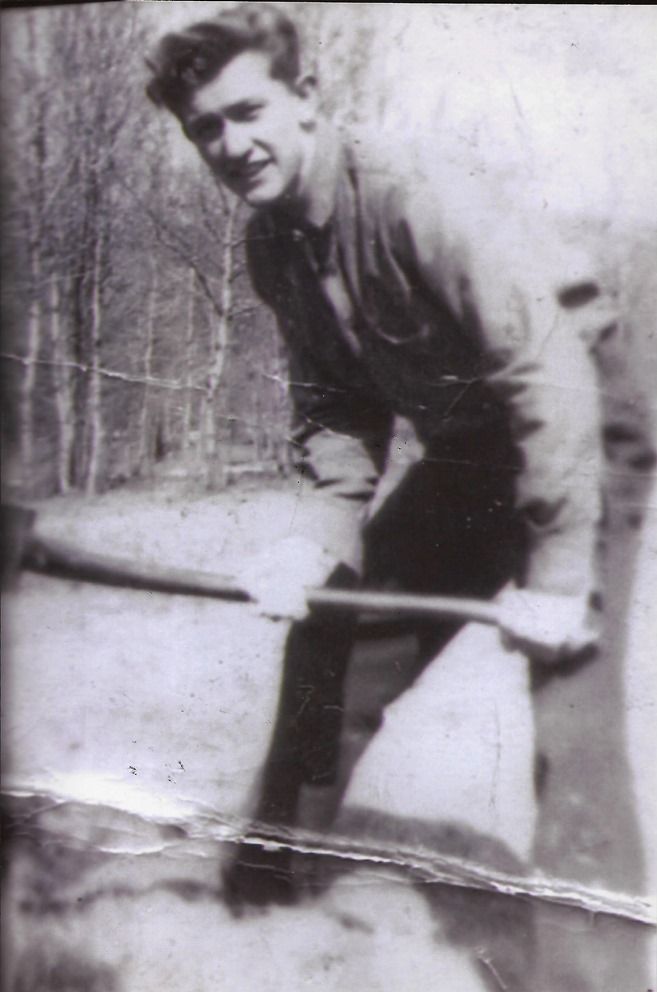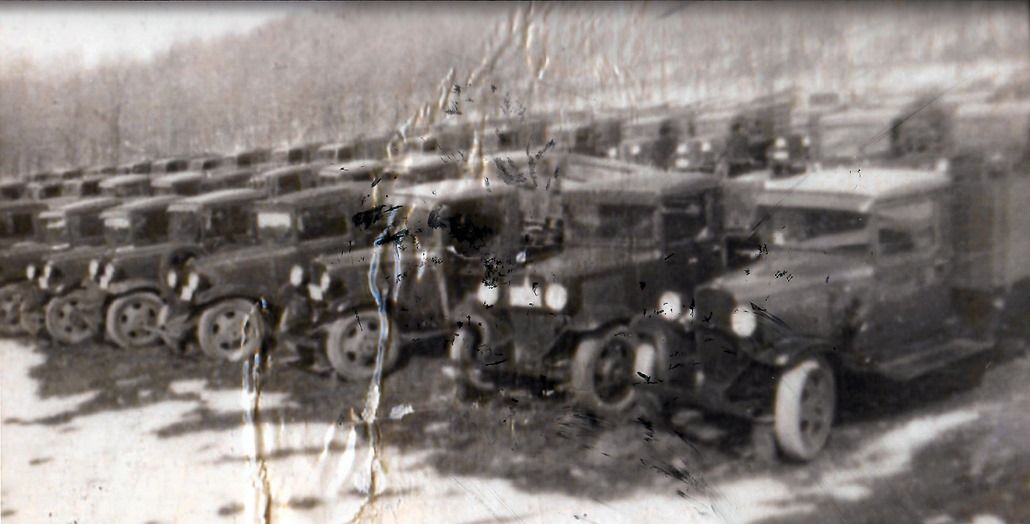For many of us who love exploring Camp Michaux, it is a marriage of insatiable curiosity with a rich and deserving history. to those who seek with tenacity and have a bit of luck on their side, Camp Michaux slowly reveals its secrets. Each time I return, I’m filled with child-like anticipation and hope. But aside from historical treasures hiding under nature’s debris, or names and dates preserved in concrete that read like messages across time, the best and most fulfilling discovery for me comes from a personal encounter with a South Philadelphia native who was a Civilian Conservation Corps (CCC) boy at the Pine Grove Furnace Camp in the 1940s.
With the help of CCC Legacy, a Virginia-based organization that recognizes the national efforts of the Civilian Conservation Corps (CCC), I found Frank Stasky. Having served at the ages of seventeen and eighteen at Pine Grove Furnace Civilian Conservation Corps Camp S-51 during the fall of 1940 and the spring of 1941, Frank considers the six months he spent at Pine Grove to be some of the best times of his life. Now, at age 92, he loves sharing his memories: “My first day at the camp we arrived at night. The next morning I was very impressed with the fall scenery and the surrounding mountains.”1
Frank and I began a long-distance friendship during the winter of 2012 and for more than three years, we have kept in touch by telephone, speaking to one another several times a year. With every conversation, I take notes as fast as I can as he shares his stories with me. Born January 8, 1923, the youngest of eight children, Frank is exactly what you might imagine a CCC boy to be when viewed through a nostalgic lens: friendly and engaging, excited about his days at Pine Grove, grateful for the opportunity to go and eager to serve. “The CCC made a man out of me and all the other young people who went in and served,” Frank said. “They treated the CCC boys like men, and as a result we became men.”2
 Frank Stasky at Pine Grove Furnace CCC Camp c.1941. Photo by camp librarian. Frank Stasky photo collection.
Frank Stasky at Pine Grove Furnace CCC Camp c.1941. Photo by camp librarian. Frank Stasky photo collection.
Frank speaks fondly about the work he and the men at Pine Grove completed with pride. Their primary mission while he was there was to cut and build Piney Mountain Road through Michaux State Forest. “you started by dragging brush. If you did a good job you got promoted to trimming the trees that were felled. And good workers received training with the axe and graduated to chopping down trees. You were considered to have more prestige if you got to cut the trees down.”3 Frank worked his way up the unofficial ranks and became a tree cutter.
All of the hard work of cutting the new road up Piney Mountain was done without power saws. “For some of the men who tired from the physical labor, they could rest and there was no pressure to work too hard.” He was impressed, however, by the strength and stamina of a particular group of Pine Grove CCC men who came from Wilkes-Barre, Scranton and Shamokin, Pennsylvania. “They were some strong, tough guys who came from the coal country,” Frank says respectfully.4 He added, “When conditions didn’t allow us to do road building, we cut out bad growth on both sides of the state highways. And we did tree planting.”5
Frank explains the organized effort and teamwork of planting hundreds of trees across large meadows with men from another nearby CCC camp. “We lined up shoulder-to-shoulder in columns of three. The first person would dig a hole; the second person behind them would select a tree from a sack he was carrying and place it in the hole. Then the third and final person would make sure the tree was packed in the soil and standing straight.”6
Frank could not have known the magnitude of the contribution he and the other men were making. According to CCC Legacy, between 1933 and 1942, the boys of the CCC planted nearly 3 billion trees nationally. But life at Pine Grove wasn’t all work and no play. Some of the boys participated in baseball and other sports, while Frank chose instead to explore the solace of the surrounding forest whenever he could. “Saturdays, on our own time, we were escorted by the state work foreman to visit the virgin trees deep in the mountains. Some did other things, but I enjoyed hiking and seeing the black bears.”7 During these excursions of six to eight men, they would enjoy following streams to discover large trees and hidden valleys.8
Frank holds a special affection for the climb to the breath-taking mountaintop vista at Sunset Rocks, just outside the camp. “It was beautiful up there, and I want to go back,” he says reminiscently. And he remembers the camp’s solitude: “We were too far out to have girlfriends,” Frank jokes, “The only people we saw were hikers on the Appalachian trail, local farmers and mountain men.”9 He remembers the mountain men he encountered as “...bearded, elusive and always alone.”10 In spite of the solitude, there were social events in the recreation building and the mess hall that Frank and his fellow CCC boys enjoyed. “There were dances, which were more like social gatherings, and the town was invited.” Local organizations provided transportation to bring young ladies to the camp from a nearby town, which he believes may have been Carlisle. Occasionally, unscheduled events like boxing matches were held. The boys from Willkes Barre and Scranton liked to take trash can lids or old metal signs to make toboggans and use them to slide down the mountain. Another activity was apple pitching where apples were placed on the end of a stick and catapulted into the distance. “There was a spirit of fun and good humor. The young guys would always be joking. There was good morale.”11
 Vehicles in the regional storage lot at the Pine Grove Furnace CCC Camp c.1941. Photo by Frank Stasky.
Vehicles in the regional storage lot at the Pine Grove Furnace CCC Camp c.1941. Photo by Frank Stasky.
There were educational opportunities as well. Frank took courses in forestry, wildlife, area history, most likely in the camp’s education building, and truck driving. In addition, “We had evening classes at Carlisle High School one day per week, and I really enjoyed getting out and walking the streets in town with my friends,” Frank says fondly. “Sometimes we’d go to Carlisle just to enjoy the town and look in the store windows. We enjoyed seeing something different.”12 The Pine Grove men also had use of the camp’s library.13 The librarian, also the camp’s photographer, would sometimes ask the men to pose for a quick shot, as he did with Frank. All of the men who enjoyed photography had free use of the camp’s photography darkroom.14
Frank liked his commanding officers, who were reserve army officers charged with the camp’s operation. “They were fair and gave commands and expected them to be carried out, and we respected that. They took their job seriously, and they did it well.”15 However, he adds, “We were told that we were a conservation corps and not military, and there was no saluting of personnel.” Frank explained the political need to distance the CCC from the military at a time when America didn’t want its young men entering another European war: “Political opponents wanted to compare the CCC youth to the Hitler youth of Nazi Germany.”16
Frank remembers morning reveille at the CCC flagpole and the evening retreat, or flag lowering. “to salute the flag, you put your hat over your left shoulder.” There were other observances of respect as well. Each Sunday after church services the men donned their dress uniforms and ties from 11:00 am to 3:00 pm for the midday meal.17
And each day, Frank tells me reverently, “When you entered the dining hall for meals, you sat quietly until grace was said.”18 After grace was spoken by a high-ranking officer, the men broke into friendly camaraderie. The U. S. Army provided the food, often cooked in large cauldrons, and served army style. “The men ate the same things that people eat today: steaks, chops, potatoes, peas and corn,” or what Frank calls “army chow.”19 “The food was good, prepared well and nutritious and everybody gained weight.” When out on the job site, trucks arrived at lunch time carrying large, thermal containers that kept food hot or cold as needed. “The forester would blow a whistle and the men would line up and be served army style. The hard work and good food with rest made most of us healthier.”20 Following the evening meal and some free time, there was “lights out” at each day’s end. While the specific time now escapes him, Frank remembers that “By a certain time everybody had to sleep.”21
After being honorably discharged from the CCC in 1941, Frank joined the U.S. Navy and served aboard three submarines during World War II. “When I was in the Navy, it was much easier to adjust to military life because of learning the CCC regimen,” he states. “others who hadn’t been in the CCC had a more difficult time making the adjustment.”22 After the war, Frank worked as a machinist at the Philadelphia Naval Shipyard for more than 25 years.13
Today, Frank enjoys his large family which includes seventeen grandchildren and ten great-grandchildren. He returned to Pine Grove with his son in the fall of 2013. Together they walked the trails using the self-guided tour booklet from the Cumberland County Historical Society. Not surprisingly, Frank found that time and nature had altered his beloved camp significantly.
He considers that trip to be his preliminary visit and plans to return, adding a hike to the base of Sunset Rocks when time and health allow. Most exciting of all for me is that Frank and I plan to return to Pine Grove together, strolling his old paths through the camp while he allows me the privilege of helping him remember some of the best days of his life.
I remain filled with child-like anticipation and hope as I look forward to learning more with Frank about this vital and rich period of our history at the site we today call Camp Michaux. The young men who served in the CCC all over the country went on to become known as “The Greatest Generation” for their service during WWII.
 Frank Stasky at Pine Grove Furnace CCC Camp c.1941. Photo by camp librarian. Frank Stasky photo collection.
Frank Stasky at Pine Grove Furnace CCC Camp c.1941. Photo by camp librarian. Frank Stasky photo collection. Vehicles in the regional storage lot at the Pine Grove Furnace CCC Camp c.1941. Photo by Frank Stasky.
Vehicles in the regional storage lot at the Pine Grove Furnace CCC Camp c.1941. Photo by Frank Stasky.